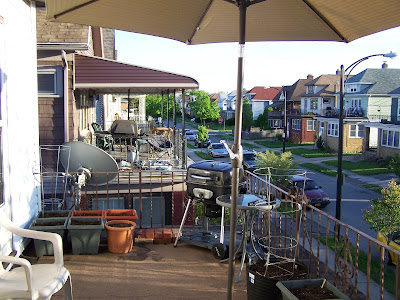The last week or so has been busy (thus the lack of posts).
The good news is that the 2012 garden season is off to a great start! So far
we’ve harvested dill (for homemade hummus), cilantro (a few times), thyme, parsley
marjoram, mint, and catnip. As an avid foodie, the herbs are one of my all-time
favorite parts of the garden. Nothing beats being able to walk outside and snip
fresh herbs of any type you need whenever you need them! I planted every herb I
could possibly think of, and this year I plan to dry as much as possible for
the winter.
 |
| Who can resist fresh marjoram? |
The herbs aren’t all we’ve harvested, though. Just yesterday
we harvested our first batch of mesclun mix, and our first two strawberries! The
Ozark Beauty is a really intense berry, and is a bit smaller than you would
find in the grocery store (as most everbearing varieties are). So far it is has
been a productive, attractive, and active plant, with tons of small berries in
various stages of ripeness now. The plants aren’t even fully developed yet, as
we planted most of them as bare root bundles, so they are still putting out
leaves at a fairly quick pace. I’m hoping they get even bushier and fill out
their boxes by fall.
 |
| Ripe Ozark Beauty! |
This weekend was a hot and humid one here, so we spent some
time going through the annual ritual of excavating the air conditioners from
their resting place in the closet. It had dawned on me as I was unearthing the
monster that would reside in our living room window that I hadn’t planned for
that when I set up the porch garden. Suddenly, a reorganization of the garden was
necessary. After what seemed like days of moving things around time and time
again, I think we have a good setup. It looks neat, the weight is spread around
evenly and is mostly against the house or along the edge on top of the
downstairs walls (important for our upstairs porch), and it is easy to get to
each plant.
 |
| The new and improved setup |
Everything is coming along really well, except for the okra.
It looks better than it did, which is encouraging, but it is still a pale
yellowish color. I think we may have planted it a bit too early and the soil
wasn’t quite warm enough for the roots. Okra likes the heat, so it did rally a
bit this weekend. The nights being in the mid 50’s to low 60’s (rather than the
40’s) has also helped. We’ll see how it goes. Okra is one of the coolest plants
to grow, and generally has done really well for us in containers. It also tends
to start off slow, so I’m hoping it gets established and flourishes soon.
A little further down the porch, the tomatoes are looking
fantastic! It’s amazing how quickly tomatoes grow, and also how quickly the
stems turn into something almost tree-like. This is especially good on our
porch, where there is seemingly always a stiff breeze. The same goes for the
peppers (one of my personal favorite things to grow!).
The stars of the garden so far have been the broccoli, Romanesco,
and the potatoes. All have gone berserk with the sunshine and warm weather. I
had worried about the broccoli being a bit crowded, but so far it is doing
extremely well and does not seem stunted at all. We’ll see about the harvest,
but so far so good!
 |
| Broccoli enjoying the sunshine |
The one crop that isn’t too happy out there in all this sun
and warmth is the lettuce. The porch is way too sunny and hot for it, so I
moved it inside to the room we had used for seedlings to see if it would do
better there.
It’s always exciting to see things really start to grow
after putting in so much time seeding, potting up, planting, etc. I’m
especially excited to see what types of tomatoes we ended up with in the
heirloom mix packet. We know we have one Brandywine
(see the photo below) but other than that it’s anyone’s guess!
 |
| One of heirloom mix tomatoes isn't quite so mysterious! |
Until next time, happy gardening!































